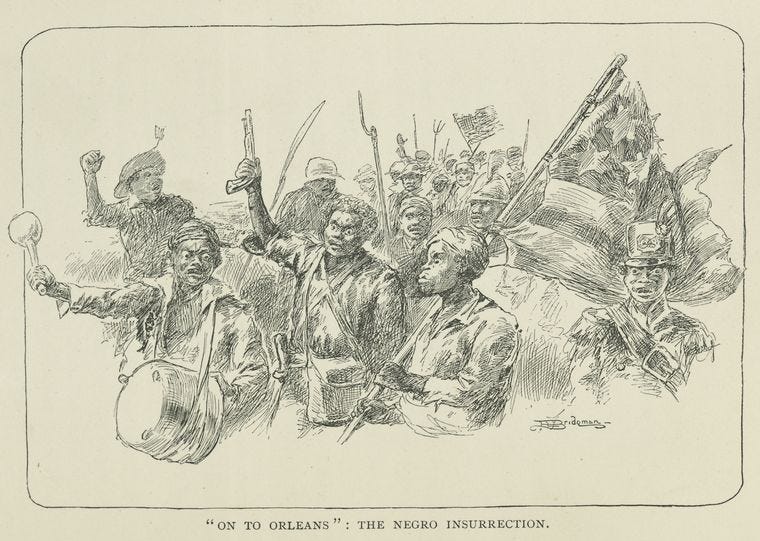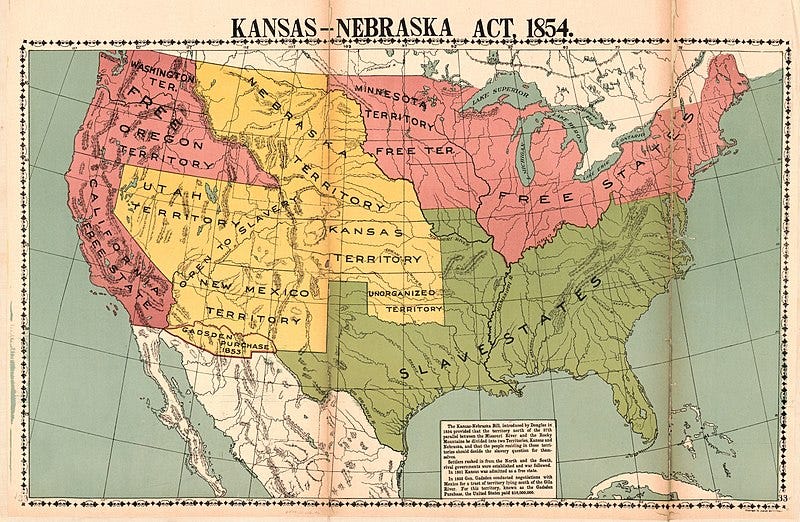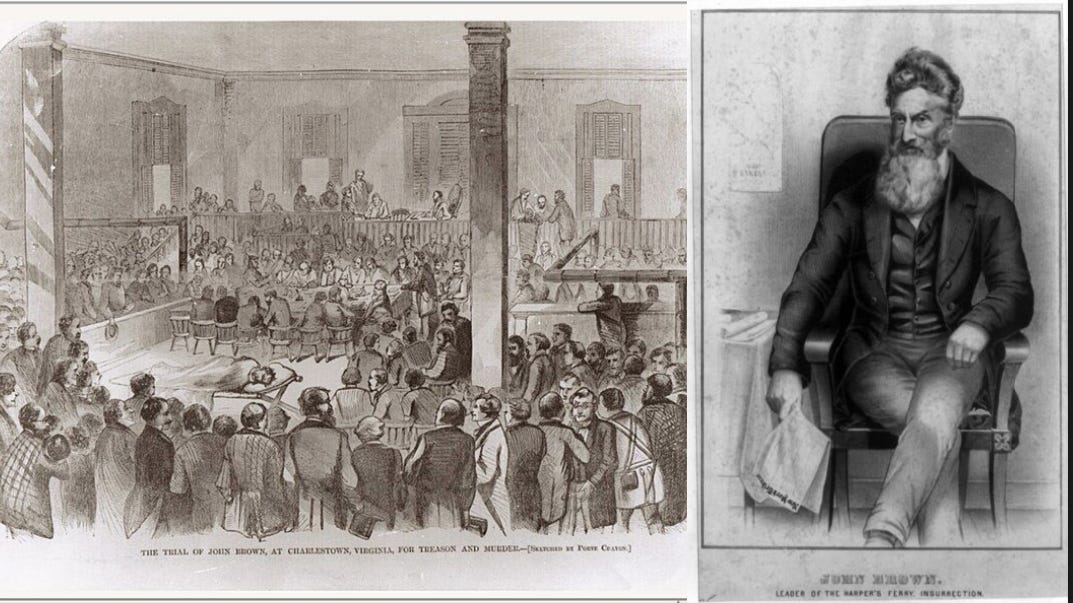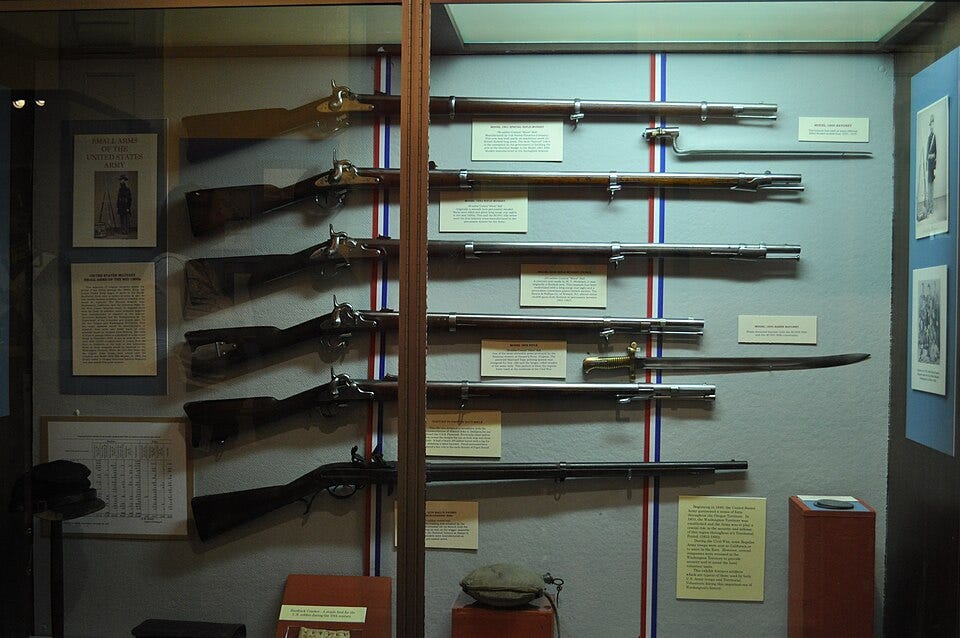The Causes of the Civil War
The sectional division over the issue of slavery leads to violence and Civil War in the United States.
The American Civil War was caused by slavery. To quote John Green: “actual historians will back me up on this.” The profitability of cotton production in the Southern States, and the use of slaves to harvest and process it, was defended by plantation owners at all costs. Abolition and a variety of reform movements calling for an end to the institution of slavery had already had a long history, but were helped along by religious revivals like the Second Great Awakening and popular movements like Transcendentalism. The justification for opposing slavery in the 19th century was very much rooted in religion and it was seen as a moral issue.
The question of the morality of slavery was decided over the backdrop of westward expansion into territories acquired by the Louisiana Purchase, Texas Annexation, the Mexican Cession, as well as the negotiation of the Oregon Territory. The political division before the Civil War was deep, sectional, and rooted in the very foundation of the country. Several compromises attempted to settle the issue (Missouri, 1850, and Kansas-Nebraska) but failed. The impact on remaining Native American communities was continuing encroachment and violent removal policies. Along with the institution of slavery, these expanding factors of manifest destiny existed alongside a rapid influx of immigrants from Europe, many who settled in the Northern, more urban states where there was more industrial jobs and large infrastructure projects like the Erie Canal and the railroads.
See also: Trail of Tears, Jackson Removal Policy
The Causes of the Civil War
In the mid-1850s, people who opposed slavery were looking for a new voice. Free Soilers, Northern Democrats, and anti-slavery Whigs formed the Republican Party. Their main stated goal was to keep slavery out of the western territories, but some pushed for outright abolition. The party grew and was ready in 1856 to challenge the older parties in power. They were not successful in 1856. However, in the Election of 1860, the new Republican Party ran Abraham Lincoln from Illinois. Lincoln was known to oppose slavery on the basis of its being morally wrong. Politically, Lincoln was not willing to end slavery at the risk of tearing the Union apart. In retrospect, the division was created with the creation of the country, and solidified in the writing of the Constitution.
The Articles of Confederation and the Constitution
Slavery had been a hot-button issue from the beginning of American history. At the Constitutional Convention in Philadelphia, the framers included the 3/5ths Compromise, a clause that counted slaves as 3/5ths of a person for the purposes of proportional representation in the House of Representatives (Congress). The same year (1787), Thomas Jefferson drafted the Northwest Ordinance. The Ordinance outlawed slavery in the “Northwest Territory” in what is now the Great Lakes region of the Midwest. This began an almost century-long debate on the issue.
The Missouri Compromise
The first major political confrontation over slavery in the United States occurred in 1820. As the United States expanded West they had to face the question of whether new territories would allow slavery or not. Missouri applied for admission to the Union as a slave state. The admission of Missouri would upset the balance of power in the Senate where at the time there were 11 free states and 11 slave states. Senator Henry Clay proposed a compromise called the Missouri Compromise. In 1820, he suggested that Missouri enter as a slave state and Maine as a free state to keep the balance of power. Congress also drew an imaginary line across the Louisiana Purchase at 36 degrees 30 minutes north latitude to establish a border between free and slave territories. North of the line would be free states (with the exception of Missouri), and south of the line would be slave states.
See also: Cassius Marcellus Clay
Resistance to Slavery and the Underground Railroad
Slaves did not want to be slaves. There is ample evidence of mutinies on the Transatlantic Slave Trade as well as revolts, rebellions and uprisings against the plantation system in use in the Americas. The Haitian Revolution comes to mind. One of the largest in the United States occurred in 1811 in Louisiana, called the German Coast Uprising. It was named for the German immigrants that had settled in the area. The revolt was led by an enslaved overseer named Charles Deslondes, who led an assault on plantations en route to New Orleans. Retaliation to the revolt was swift and cruel, with Charles Deslondes being brutalized and burned, and the heads of conspirators placed on pikes outside New Orleans.
If it’s not obvious at first glance, further evidence of resistance to slavery took shape on the freedom road known as the Underground Railroad. The Underground Railroad was a secret network of smuggling routes and safe-houses that helped enslaved people escape the system of slavery in the United States. Refugees were guided by songs, stories, maps, and conductors; the most famous of which is Harriet Tubman. It had many routes, but only 3 major exits. Enslaved people seeking freedom could escape to northern states and/or Canada where slavery and the trade had been outlawed, South to Mexico where the practice was outlawed in 1829, or southeast through Florida to either join the Seminole resistance or escape through Caribbean trade routes to take to the high seas. It’s difficult to count how many slaves escaped through the Underground Railroad, but estimates put it between 100,000 and 500,000 by the end of the Civil War.
Nat Turner's Rebellion (or Southampton Insurrection) was a slave rebellion that took place in Virginia in 1831. Led by Nat Turner, rebel slaves killed from 55 to 65 people, with at least 51 being white. The rebellion was put down within a few days and officially ended after Nat Turner was captured and killed. There was widespread fear in the aftermath of the rebellion, and white militias organized in retaliation against the slaves. The state executed 56 slaves accused of being part of the rebellion. Many non-participant slaves were also punished. Approximately 120 slaves and free African Americans were murdered by militias and mobs in the area. Across the South, state legislatures passed new laws prohibiting education of slaves and free black people, restricting rights of assembly and other civil rights for free black people, and requiring white ministers to be present at all worship services. There is no one revolt or uprising that alone was pivotal in swaying the nation towards war, but the German Coast Uprising and Nat Turner’s Rebellion were two of the largest.
See also: Slave Bible
The Pen or the Sword
In 1828, an escaped slave with a daughter sued and won custody of her son who had been illegally sold into slavery. In 1843 the woman changed her name to Sojourner Truth, at which point she began giving speeches advocating the abolition of slavery. By 1851 she gave possibly one of the most famous speeches of American History, now known as Ain’t I a Woman.
In 1845 another famous freedman made history. Frederick Douglass published his memoir: The Narrative of the Life of Frederick Douglass, an American Slave. Speeches of abolitionists such as Sojourner Truth and written works and letters from authors such as Frederick Douglass give a relevant look into the momentum of the abolition movement. Other authors/publishers such as Harriet Beecher Stowe and William Loyd Garrison had an impact on public perception at the time.
The Compromise of 1850
In 1850, California applied for admission as a free state following the discovery of gold. Once again, the balance of power in the Senate was threatened. The South did not want to give the North a majority in the Senate. They also feared that more free states would be carved from the Mexican Cession. Members of Congress, spearheaded by Henry Clay, agreed upon the Compromise of 1850. Many Republicans such as Maine’s Daniel Webster opposed the law. John C. Calhoun, a senator of South Carolina stated the South would not compromise. He demanded that slavery be allowed in the western territories and that there be a tough fugitive-slave law.
The Compromise of 1850 had four parts: 1) California entered as a free state after the 1849 Goldrush. 2) The rest of the Mexican cession was divided into New Mexico and Utah. In each state, voters would decide the issue of slavery. 3) Slave trade was ended in Washington D.C. 4) A strict new fugitive-slave law was passed. The Fugitive Slave Law required that all citizens were obligated to return runaway slaves. People who helped slaves escape could be jailed and fined. The law enraged Northerners because it made them feel a part of the slave system that they considered a moral abomination, many on religious grounds.
The Kansas-Nebraska Act
In 1854, Stephen Douglas introduced a bill to help solve the problem of slavery in the new Nebraska territory. He proposed that Nebraska be divided into two territories — Kansas and Nebraska. The settlers of the new territories would decide whether they would be slave or free (popular sovereignty). This proposal set off a storm of controversy because it effectively undid - or nullified - the Missouri Compromise. Southerners supported the act, while Northerners felt it was a betrayal. The Act set off bitter violence in the Kansas territory, known as Bleeding Kansas. Pro and Anti-slavery forces set up rival governments, more than 200 people died. The town of Lawrence was destroyed by pro-slavery forces. In revenge, John Brown and a small group killed five pro-slavery supporters in the middle of the night; beheaded them with broadswords.
Dred Scott v. Stanford (The Dred Scott Decision)
In 1857, the United States Supreme Court made a landmark ruling in the Dred Scott case. Dred Scott was a slave who applied for freedom. He claimed that because his master had taken him to the free territories of Illinois and Wisconsin, he should be free. The court ruled that because Dred Scott was not considered a citizen, but property, he could not file a lawsuit. The Court also ruled that Congress had no power to decide the issue of slavery in the territories. This meant that slavery was legal in all the territories and the Missouri Compromise was unconstitutional.
John Brown’s Raid on Harper’s Ferry
In 1859, John Brown and a group of followers organized a raid on Harpers Ferry, Virginia, a federal arsenal. Brown hoped that slaves would come to the arsenal and he would then provide weaponry for a massive uprising. It was John Brown’s belief that slavery could be ended only through the use of violence. Brown was unsuccessful, and troops led by Robert E. Lee killed 10 raiders and captured John Brown. He was found guilty of murder and treason at trial and sentenced to death. He was hung. Brown conducted himself with great composure during his trial. While many northerners thought his plan to lead a slave revolt was misguided, they also saw Brown as a hero. Southerners felt that the North wanted to destroy slavery and the South along with it.
See Also: Red Legs, Frances Ellen Watkins Harper, John Brown’s Last Speech
Election of 1860
The Southerners’ reaction to the Election of 1860 was strong. Abraham Lincoln was elected President. The South - especially the planter class of white plantation owners - thought he was radical and dangerous. Lincoln earned this perception in his debates with Democratic Senator Stephen Douglas, known as the Lincoln-Douglas Debates. Southerners felt that the country had put an abolitionist in the White House. In 1860, South Carolina seceded from the Union. By February of 1861, Alabama, Florida, Texas, Georgia, Louisiana, and Mississippi had seceded. In 1861, the seven states held a convention in Montgomery, Alabama, and formed the Confederate States of America. A politician from Mississippi named Jefferson Davis was elected president of the Confederacy.
As Southerners resigned their seats in the Senate and the House, Republicans were able to pass bills for projects that had been blocked by Southern Senators before the war, including the Morrill Tariff, to pay for land grant colleges (the Morrill Act), a Homestead Act, a transcontinental railroad (the Pacific Railway Acts), and the National Banking Act to authorize United States Notes and introduce the income tax to help finance the war.
After Lincoln took the oath of office in 1861, he announced that no state can lawfully leave the Union. He declared, however, there would be no war unless the South started it. The South started to take possession of all Federal buildings — forts and post offices. The South took control of three forts in Florida and attacked Fort Sumter in South Carolina. It was 1861 and the Civil War had begun.
The 23 states of the North, or the Union had enormous advantages in industrial capacity, agricultural production, population, railroad construction and the use of a Navy. The South, or the Confederacy had the advantages of more experienced military leaders and would mostly fight a defensive war on terrain they were familiar with, whereas the North had to blockade and invade the South to force capitulation. The Union plan to do this was called the Great Snake or Anaconda Plan.
The Northern industrial advantages led to the manufacture of innovations in military weaponry. The Civil War saw the first use of auto-repeating firearms and the first glimpses of what would now be considered machine guns. Photography was also saw widespread use during the war with the work of one Mathew Brady. Further, the Civil War saw the first use of ironclads, or ships plated and built out of iron and steel rather than wood.
Since the war was being fought over the issue of slavery, the Union adopted a policy of “war contraband,” meaning that any slaves that crossed the border into the Union would not be returned, as they were as part of the Fugitive Slave Act passed along with the Compromise of 1850, instead they were considered confiscated property and placed in “contraband camps.” These camps shadowed Union Army camps and would perform labor for the Army, and many men would join the war effort in black regiments after 1863.






















